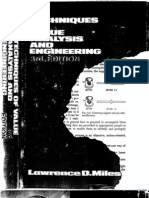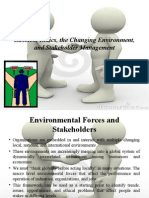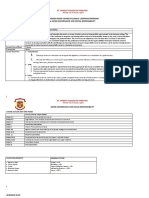Case Analysis
Case Analysis
Uploaded by
Arsal SiddiqiCopyright:
Available Formats
Case Analysis
Case Analysis
Uploaded by
Arsal SiddiqiCopyright
Available Formats
Share this document
Did you find this document useful?
Is this content inappropriate?
Copyright:
Available Formats
Case Analysis
Case Analysis
Uploaded by
Arsal SiddiqiCopyright:
Available Formats
A COMPREHENSIVE APPROACH TO ANALYZING STRATEGIC PROBLEMS AND CASES
A CASE ANALYSIS FRAME WORK The basic approach to case analysis is a four stage process, comprising of; Define the Problem Formulate Alternates Evaluate and Compare the Alternatives Select and implement the Chosen Alternative. The problem solving approach to case analysis is not recommended for the students as they are not experienced in the analysis of strategic problems and cases thus the basic framework may be inadequate and oversimplified. AN EXPANDED FRAMEWORK FOR CASE / STRATEGIC ANALYSIS Analyze and Record Current Situation Analyze & Record Problems & their Core Elements Formulate, Evaluate & Record Alternative Courses of Action Select, Justify & Record the Chosen Course of Action & Implementation.
ANALYZE AND RECORD THE CURRENT SITUATION Purpose; Analyzing and recording the current situation is important for three reasons. Develop Clear Understanding of Current Situation; It is impossible to determine what courses of action are appropriate, until we have developed a clear understanding of current situation. In other words, we have no basis in deciding how to improve a situation until we know what that situation is.
Investigate Current & Potential Problems; The major purpose of this stage of analysis is to investigate the current and potential problems involved in the case. By sequentially analyzing all elements of current situation, the analyses clarify those elements and masses evidence that they are the central issues. Determine the Level of Analysis; Level of Analysis means the overall scope of the problem. For example, some cases emphasize issues arises at the industry level, whereas others focus onorganizational&departmental level. Clearly, determining the appropriate level of analysis is a very important aspect of case analysis. Steps of carrying out Environmental Analysis In completing the environmental analysis, the analyst must keep six major steps in mind: Separate Relevant from Superfluous Information; determine that what information is important and what should be ignored. Difference betweenSymptoms and Problems Symptoms; Indicators of problems but not the problems i.e, a decline in sales in a particular sales territory is a symptom of a problem and not the problem itself. Problem; It is the root cause of decline. Perhaps the fixed representative has stopped making the sales on minor problem, as he is unsatisfied with the firms compensation plan. Difference between Facts and Opinion; The analyst must bemindful of the difference between facts and opinions in recording the current situation. Facts; An objective statement or account of information e.g a financial statement or balance sheet. Opinions; Subjective interpretation of a facts or situation ----- I believe that sales will increase by 20% next year. Collect Additional Information for Situational Analysis; Collect additional information outside the case ---- this information is useful for putting the problem in context.
Evaluate Reasonableness & Necessity of Assumptions; Where it is difficult to characterize the current situation completely, at this point assumptions can be made. Draw Explicit Conclusions; When an analyst concludesthat a certain aspect of environmental analysis has no bearing on the case, he should say so explicitly. Steps of Completing Current Situation Organization History:An overview about the organization to cover its brief history, incorporation, products, plants facilities / technologies / capabilities. Organizations Products:Also give an overview about its clientele and product mix, as illustrated in an example of a beverage manufacturer; PEPSI Cans 1.5 lit bottle 2 lit disposable 4.5 lit disposable 7-UP Cans 1.5 lit bottle 4.5 lit disposable Miranda 1.5 lit bottle 4.5 lit disposable MINERAL WATER 1.5 lit bottle 4.5 lit bottle 25 lit bottle 35 lit bottle
Environmental Analysis: Carry out environmental analysis with regard to General, Operating and internal environment. Identify Organizational Direction by evaluating Firms Existing Mission and Objectives. Carry out SWOT:Identify Organizations external Opportunities, Threats and internal Strength and Weaknesses. Analysts should be able to ascertain; Firms existing strategies and threats. Competitors and their strategies and describe problems firm is facing under this aspect.. Describe organizational functional condition.
If required describe the salients of other functional areas. Study Areas in Environmental Analysis In very few cases all each component of General, Operational & Internal components and aspects are crucial for analysis. However, until each component or aspect is considered, there is no way to judge its relative importance. The key task is to consider every possible environmental element in order to access problems and opportunities in the case situation. Keeping a detailed record of all the relevant information uncovered in the environmental analysis is important. Table 12.2 presents a work sheet for recording this information and further investigating its impact on the case. While undertaking environmental analysis, the analyst must keep following six major points in mind. GENERAL ENVIRONMENT Economic component; Economic variables as inflation, unemployment & interest rates. Social component; Social variables as educational levels, customs, beliefs & values. Political component; Lobbying activities and government attitudes toward business. Legal component; Legal variables as federal, state and local legislation Technological component; Level of technology, Technological trends OPERATING ENVIRONMENT Customer component; Target markets and customer profiles. Competition component; Strengths, weaknesses, strategies & market share of competitors Labor component; Supply of labor, skills & competence of available labor. Supplier component; Relationships between suppliers, Resources and the firm International component; International factors / trends INTERNAL ENVIRONMENT
Organizational aspects; Organizational or managerial issues, concepts and analysis, to include; Organizational structure and management system Personnel and administrative structure Briefly comment on the company from organizational point of view. Marketing aspects; Marketing issues, concepts and analysis Financial aspects; Financial issues, concepts and analysis Personnel aspects; Personnel issues, concepts and analysis Production aspects; Production issues, concepts and analysis ANALYZE& RECORD PROBLEMS&THEIR CORE ELEMENTS Purpose; Is to help analyst recognize the major problems and issues of the current situation. Identifying the Inconsistencies; comparing the case situation with an optimal situation should highlight the inconsistencies between them. An optimal situation means a situation in which the activities are performed in a manner consistent with sound managerial principles and logic. Example 1; Analysis of a particular case revealed that although an organization has done an excellent job of setting objectives, its current strategy was not designed appropriately for accomplishing these objectives. The deviation in strategy is probably symptomatic of a deeper managerial problem. Example 2; Reduction in sales despite the fact that overall market size is increasing by 4 6 % annually. Recognizing and Recording of problem is critical for case analysis. In case roots of problems are not determined, explicitly stated and understood the case analysis has little problem. If roots of problems are not determined and explicitly stated and understood, the reminder of the case analysis has little merit because it does not focus on key issues.
Example; Organization excellently set the objectives, however, strategy not designed appropriately for accomplishing these objectives. Table12.3 presents a worksheet to help: Analyze, recognize and record problems. This table emphasizes the importance of providing evidence that a particular problem is a critical one. Simply stating that a particular issue is the major problem is not sufficient; analysis must also provide the reasoning by which they reached this conclusion.
FORMULATE, EVALUATE & RECORD ALTERNATIVE COURSES OF ACTION Purpose; What can be done to resolve problems already defined? Alternate Courses of Action; Regardless of the method used to develop alternatives, the final list should usually include only three to four of the better solutions. Alternate methods commonly used are; Brainstorming;Identify alternate courses of action and develop as many alternatives as possible and then reduce the list to a workable number of most . Search Each Alternate; Another approach is to screen each alternate as it is developed, saving for further evaluation and comparison only those that meet pre-determined feasibility criteria. Formulation and Recommendations of Alternatives Formulation of Alternatives Analyze various options to resolve the problems. Feasible alternatives are evaluated. Recommendations Select the alternate that best solves the problem. Regardless of alternate selected justify the choice; and compare it with companys plan. Specific strategies and long term objectives be recommended. Evaluation of Alternatives; After listing the alternatives, analysts evaluates them in term of strengths and weaknesses;
Strengths; include anythingfavorable about an alternate, such as increased efficiency increased productivity, cost savings, or increased sales and profits. Weaknesses; include anything unfavorable about an alternative, such as its cost in time, money, or other resources or its relative ineffectiveness at solving the problem. General Worksheet for Evaluating Alternative Courses of Action. Table 12.4 offers a worksheet in this regard. Alternative 1 Description of Alternative Strengths & Weaknesses of Alternatives Overall Evaluation of Alternative Repeat as necessary for each feasible alternative
SELECT, JUSTIFY & RECORD CHOOSEN COURSE OF ACTION & IMPLEMENTATION Purpose; Select the alternate that best solves the problem, while creating a minimum of new problems. Select the Alternate that best solves the problem after careful analysis. This alternative is selected via careful analysis of strengths and weaknesses of each alternate scrutinized in the previous stage. Justify Selection; Recording the logic and reasoning that led the selection of a particular alternative are very important. Regardless of which alternative is selected the analyst must justify choice. Implementation Plan; The final phase in the case analysis is devising the action oriented implementation plan. It should emphasize upon following;
How could the organization best implement what analyst recommend? What implementation problems are envisaged? How could firm avoid and solve these problems. General Worksheet for Implementing the Chosen Alternative; Table 12.5 What Should be Done to Implement the Chosen Alternative effectively? Specific Recommendation Justification Who Should be Responsible for Implementing the Chosen Alternative? Specific Recommendation Justification When and Where the Chosen Alternative be Implemented Specific Recommendation Justification How Should the Chosen Alternative be Evaluated for Success or Failure? Specific Recommendation Justification
PITFALLS TO AVOID IN CASE ANALYSIS Inadequately Defining the Problem Analysts often recommend courses of action without adequately understanding or defining the problems those characteristics the case. Sometime analysts jump to premature conclusions upon first reading the case Sound case analysis absolutely depend a clear understanding of major case problem.
You might also like
- Techniques of Value Analysis and Engineering by Lawrence D MilesDocument383 pagesTechniques of Value Analysis and Engineering by Lawrence D MilesGeorge Mathew84% (38)
- SCAT Systematic Cause Analysis TechniqueDocument36 pagesSCAT Systematic Cause Analysis TechniqueIndra Wardhana88% (8)
- Character and Competency Framework (DIR MAGSALOS)Document55 pagesCharacter and Competency Framework (DIR MAGSALOS)eli larop100% (2)
- Chapter 5 Event OperationsDocument17 pagesChapter 5 Event OperationsNadiah LasuanNo ratings yet
- (Economic Themes) Impact of National Culture On International Human Resource ManagementDocument20 pages(Economic Themes) Impact of National Culture On International Human Resource ManagementAshleyKumarNo ratings yet
- Social Studies Jhs 1 - 3Document51 pagesSocial Studies Jhs 1 - 3Mohammed Abu Shaibu71% (7)
- Virzi 1992Document12 pagesVirzi 1992Maria IsabelNo ratings yet
- The Budgeting and Strategic Planning Solution: Software SupportDocument6 pagesThe Budgeting and Strategic Planning Solution: Software SupportBeNoNo ratings yet
- Business Research Methods: Fourth EditionDocument39 pagesBusiness Research Methods: Fourth EditionMaqsood Ali JamaliNo ratings yet
- Autocratic ModelDocument5 pagesAutocratic ModelVenkatesh KesavanNo ratings yet
- Chapter VI - Strategy Formulation - Situation Analysis and Business StrategyDocument40 pagesChapter VI - Strategy Formulation - Situation Analysis and Business StrategyPooja T MagarNo ratings yet
- Human Resource PlanningDocument15 pagesHuman Resource PlanningKurnool LionsNo ratings yet
- Internal Assignment BBA IIIDocument6 pagesInternal Assignment BBA IIIMamtaSharmaNo ratings yet
- Assignment On Strategic Evaluation & ControlDocument13 pagesAssignment On Strategic Evaluation & ControlShubhamNo ratings yet
- Answers - Porters Five Forces Activity WorksheetDocument4 pagesAnswers - Porters Five Forces Activity WorksheetDewald AlbertsNo ratings yet
- Dev't PPA (Chap-Three)Document22 pagesDev't PPA (Chap-Three)ferewe tesfayeNo ratings yet
- Introduction To Business - Chapter 3 - Entrepreneurship, Franchising and Small BusinessDocument26 pagesIntroduction To Business - Chapter 3 - Entrepreneurship, Franchising and Small BusinessHamidul Islam100% (1)
- Human Resource ManagementDocument22 pagesHuman Resource ManagementKEDARANATHA PADHYNo ratings yet
- Chapter 16 - Organizing For Global MarketingDocument12 pagesChapter 16 - Organizing For Global MarketingNihale EttakkalNo ratings yet
- Role of The HR FunctionDocument7 pagesRole of The HR Functionthakkardhara13No ratings yet
- Strategy Evaluation and ControlDocument39 pagesStrategy Evaluation and ControlTansen John100% (1)
- Unit 3Document64 pagesUnit 3Senthil JS0% (1)
- Diversity ManagementDocument25 pagesDiversity Managementpari shuklaNo ratings yet
- Company Regulatory Legislations in IndiaDocument42 pagesCompany Regulatory Legislations in IndiaAngad SinghNo ratings yet
- Exchange Rate Management SystemsDocument3 pagesExchange Rate Management SystemsMonalisa PadhyNo ratings yet
- MGT8200 - Chapter 2Document7 pagesMGT8200 - Chapter 2Si WongNo ratings yet
- Nature and Characteristics of Strategic DecisionsDocument6 pagesNature and Characteristics of Strategic DecisionsAhsan ShabirNo ratings yet
- Behavioural Issues in Strategy ImplementationDocument2 pagesBehavioural Issues in Strategy ImplementationRicha Garg100% (1)
- Motives of Internationalization of FirmsDocument5 pagesMotives of Internationalization of FirmsNeeraj Jain100% (1)
- Long Term Sources of FinanceDocument26 pagesLong Term Sources of FinancemustafakarimNo ratings yet
- Chapter 15 Lecture 1 CSR & EthicsDocument15 pagesChapter 15 Lecture 1 CSR & Ethicsanuraag1710No ratings yet
- Personal Equity and Retirement Account (Pera)Document12 pagesPersonal Equity and Retirement Account (Pera)lorkan19No ratings yet
- Chapter 3 The External AssessmentDocument50 pagesChapter 3 The External AssessmentNURAIN AMALUDINNo ratings yet
- Exploratory ResearchDocument28 pagesExploratory ResearchBasavaraj SulibhaviNo ratings yet
- Dfi 306 Public FinanceDocument134 pagesDfi 306 Public FinanceElizabeth MulukiNo ratings yet
- International Business EnvironmentDocument32 pagesInternational Business EnvironmentAks Sinha100% (1)
- Chapter 3 Integrative Managerial IssuesDocument38 pagesChapter 3 Integrative Managerial IssuesNiz IsmailNo ratings yet
- The Nature of Strategy EvaluationDocument9 pagesThe Nature of Strategy Evaluationyosef bekeleNo ratings yet
- Nature and Importance of TraningDocument5 pagesNature and Importance of Traningarpit vermaNo ratings yet
- Introduction To International Marketing ResearchDocument7 pagesIntroduction To International Marketing ResearchPrem Zip Zap ZoomNo ratings yet
- Model Question For International Business, 2 Semester Masters in Business StudiesDocument2 pagesModel Question For International Business, 2 Semester Masters in Business StudiesDevkota SunilNo ratings yet
- IMChp 1Document7 pagesIMChp 1Mona A HassanNo ratings yet
- Role EfficacyDocument6 pagesRole EfficacyMishahel SusuNo ratings yet
- Autocratic LeadershipDocument4 pagesAutocratic LeadershipJose Emmanuel FranciaNo ratings yet
- Strategic Management: Lecture 1: What Is Strategy? What Is Strategy?Document21 pagesStrategic Management: Lecture 1: What Is Strategy? What Is Strategy?Carl ReyNo ratings yet
- Financial Ratios Analysis & Comparing Financial Performance of Two Pharmaceuticals Companies - (Cipla and Lupin)Document10 pagesFinancial Ratios Analysis & Comparing Financial Performance of Two Pharmaceuticals Companies - (Cipla and Lupin)nithiyaashriNo ratings yet
- International Management AssignmentDocument5 pagesInternational Management AssignmentSUBODH DHONGADENo ratings yet
- The Market For Events and The Event StakeholderDocument15 pagesThe Market For Events and The Event StakeholderCindy Ortiz GastonNo ratings yet
- What Is The Relevance of The Research-Based View of The Firm To Strategic Management in A Global EnvironmentDocument1 pageWhat Is The Relevance of The Research-Based View of The Firm To Strategic Management in A Global EnvironmentENVplus100% (3)
- Business Ethics, Stakeholder ManagementDocument17 pagesBusiness Ethics, Stakeholder ManagementRempeyekNo ratings yet
- 3.3.4 Normal Profits, Supernormal Profits and LossesDocument3 pages3.3.4 Normal Profits, Supernormal Profits and LossesThanujiNo ratings yet
- Buyer Behaviour of Cell Phones: Executive SummaryDocument15 pagesBuyer Behaviour of Cell Phones: Executive SummaryRashmi GowdaNo ratings yet
- Business Ethics, The Changing Environment, andDocument19 pagesBusiness Ethics, The Changing Environment, andKritika JainNo ratings yet
- Business Ethics and Global Business EnvironmentDocument6 pagesBusiness Ethics and Global Business EnvironmentSiva Kumar100% (1)
- Strategic Management:: Creating Competitive AdvantagesDocument108 pagesStrategic Management:: Creating Competitive AdvantagesSharath KannanNo ratings yet
- SMG Strategic Management Maturity ModelDocument6 pagesSMG Strategic Management Maturity ModelGogo CrimemasterNo ratings yet
- Threefold Concept of ManagementDocument6 pagesThreefold Concept of ManagementJackNo ratings yet
- Outcomes-Based Course Syllabus/ Learning Program For Good Governance and Social ResponsibilityDocument8 pagesOutcomes-Based Course Syllabus/ Learning Program For Good Governance and Social ResponsibilityLeslie Ann Elazegui Untalan100% (1)
- Unit 1Document29 pagesUnit 1Kuthubudeen T MNo ratings yet
- Contemporary Management - NotesDocument6 pagesContemporary Management - NotesMahmoud NassefNo ratings yet
- Explain How To Conduct An External Strategic-Management AuditDocument7 pagesExplain How To Conduct An External Strategic-Management AuditJan GeleraNo ratings yet
- 6b EPRG FrameworkDocument2 pages6b EPRG FrameworkNamrata SinghNo ratings yet
- Strategy ImplementationDocument24 pagesStrategy ImplementationJEFFERSON CUTENo ratings yet
- One of The Benefits of A Strategy Map Is That Goals and How They Are Linked Can Be Communicated Clearly To Everyone in The OrganizationDocument3 pagesOne of The Benefits of A Strategy Map Is That Goals and How They Are Linked Can Be Communicated Clearly To Everyone in The OrganizationDhea CahyaNo ratings yet
- Value Chain Management Capability A Complete Guide - 2020 EditionFrom EverandValue Chain Management Capability A Complete Guide - 2020 EditionNo ratings yet
- Curriculum Vitae: Sheikh Adil AnisDocument1 pageCurriculum Vitae: Sheikh Adil AnisArsal SiddiqiNo ratings yet
- Employees Continued Usefulness To The Employees Personal /professional - Employees Personal AdvancementDocument3 pagesEmployees Continued Usefulness To The Employees Personal /professional - Employees Personal AdvancementArsal SiddiqiNo ratings yet
- Satisfaction of Employee: Compensation and AdminitrationDocument8 pagesSatisfaction of Employee: Compensation and AdminitrationArsal SiddiqiNo ratings yet
- 31-Dec-10 31-Dec-09 Assets: Period EndingDocument4 pages31-Dec-10 31-Dec-09 Assets: Period EndingArsal SiddiqiNo ratings yet
- XahaaaaaaaDocument2 pagesXahaaaaaaaArsal SiddiqiNo ratings yet
- GDP Contribution of Services in Italy: Source of Information: InternetDocument4 pagesGDP Contribution of Services in Italy: Source of Information: InternetArsal SiddiqiNo ratings yet
- Chapter No. 8: Atmospherics and Retail Space ManagementDocument39 pagesChapter No. 8: Atmospherics and Retail Space ManagementArsal SiddiqiNo ratings yet
- Engl 102 Syllabus Spring 2015Document17 pagesEngl 102 Syllabus Spring 2015Kimberly GoinsNo ratings yet
- TQMDocument4 pagesTQMsalamat lang akinNo ratings yet
- MBA, 1st Year: Human Resource ManagementDocument28 pagesMBA, 1st Year: Human Resource ManagementSankit Mohanty100% (1)
- Item Analysis Report On Pilot Testing 1ST QuarterDocument512 pagesItem Analysis Report On Pilot Testing 1ST QuarterRA CastroNo ratings yet
- Integrating ProgrammingDocument44 pagesIntegrating ProgrammingTri Joko DaryantoNo ratings yet
- Ict Implementation in Governance PDFDocument11 pagesIct Implementation in Governance PDFkomallotulkarNo ratings yet
- Freddie Cox Unit 3 - Assessment SheetDocument7 pagesFreddie Cox Unit 3 - Assessment Sheetapi-555387623No ratings yet
- Feature-Based Approaches To Semantic Similarity Assessment of Concepts Using WikipediaDocument18 pagesFeature-Based Approaches To Semantic Similarity Assessment of Concepts Using WikipediaLakshay BansalNo ratings yet
- Continuous AssessmentDocument14 pagesContinuous AssessmentGracee GraceeNo ratings yet
- Eamcet 2006 Engineering PaperDocument14 pagesEamcet 2006 Engineering PaperandhracollegesNo ratings yet
- Evaluation GUIDEDocument15 pagesEvaluation GUIDERichard BaileyNo ratings yet
- Nursing CARE PLAN PsychDocument7 pagesNursing CARE PLAN Psychtiptopyo100% (1)
- Full Report in Idnesh ModifiedDocument150 pagesFull Report in Idnesh ModifiedananthakumarNo ratings yet
- BSC It 6TH SemDocument19 pagesBSC It 6TH SemAbid AliNo ratings yet
- ESP Course DesignDocument12 pagesESP Course DesignDesy Liliani HusainNo ratings yet
- FMVSS Vehicles With Automated Driving SystemsDocument248 pagesFMVSS Vehicles With Automated Driving SystemsClaire DevNo ratings yet
- Functions of DENRDocument8 pagesFunctions of DENRAngelie Lape75% (4)
- Call Center ToolkitDocument12 pagesCall Center Toolkitharindra1100% (1)
- Once - or On Revision Once Once Once OnceDocument2 pagesOnce - or On Revision Once Once Once OncemetroroadNo ratings yet
- Design and Implementation of Rapid Assessment Approaches For Water Resource Monitoring Using Benthic MacroinvertebratesDocument15 pagesDesign and Implementation of Rapid Assessment Approaches For Water Resource Monitoring Using Benthic MacroinvertebratesJojo MarinayNo ratings yet
- Mba-III Sem STPRDocument18 pagesMba-III Sem STPRNeeraj TiwariNo ratings yet
- Federal Guidelines For Dam SafetyDocument40 pagesFederal Guidelines For Dam SafetyjnfNo ratings yet
- A Systematic Approach Towards Restoration of Heritage Buildings-A Case StudyDocument10 pagesA Systematic Approach Towards Restoration of Heritage Buildings-A Case StudyNi MeshNo ratings yet
- 0457 Example Candidate Responses Paper 3 (For Examination From 2018)Document26 pages0457 Example Candidate Responses Paper 3 (For Examination From 2018)Tanya ValechaNo ratings yet
































































































